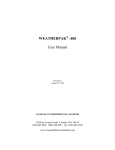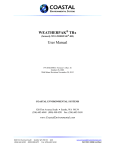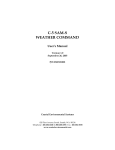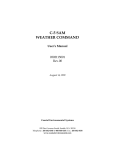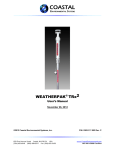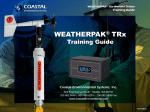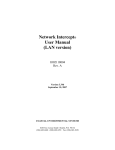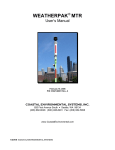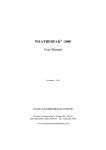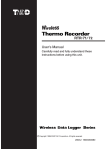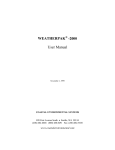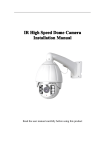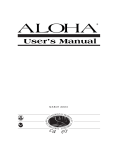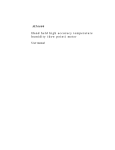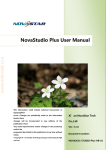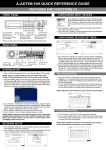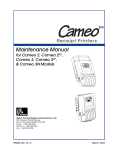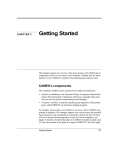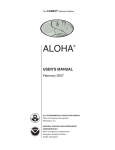Download WEATHERPAK -400 User Manual - Coastal Environmental Systems
Transcript
WEATHERPAK® -400 User Manual Revision 7 (V7) October 28, 2002 COASTAL ENVIRONMENTAL SYSTEMS 820 First Avenue South • Seattle, WA 98134 (206) 682-6048 (800) 488-8291 Fax: (206) 682-5658 www.CoastalEnvironmental.com WEATHERPAK®-400 TABLE OF CONTENTS LIST OF FIGURES 1 IMPORTANT NOTES 2 1.0 INTRODUCTION 3 2.0 INSTALLATION 2.1 Siting Considerations 2.2 Tower Mount 2.3 Van Mount 2.4 Receiver Box Connections 2.5 Connection to a Computer 4 4 5 7 9 10 3.0 OPERATION 3.1 Receiver Box Display Interpretation 3.2 Using the Computer with Plume Modeling Software 3.3 Data Line Interpretation 11 11 12 14 4.0 MAINTENANCE 4.1 Periodic Maintenance Schedule 4.2 Troubleshooting 4.3 Replacing Tower Batteries and Fuse 15 15 15 17 EQUIVALENT WIND CHILL TEMPERATURES 18 HEAT STRESS INDEX 19 Coastal Environmental Systems (206) 682-6048 Page i WEATHERPAK®-400 USER MANUAL LIST OF FIGURES 1. Placement of the WEATHERPAK ® on top of vehicles 4 2. The WEATHERPAK ®-400TRX with Tower 5 3. Tower Mount Set Up 6 4. The WEATHERPAK® -400VM (Van Mount) 7 5. Van Mount Quick Release 8 6. Receiver Box Rear Panel Connections 9 7. Computer with Receiver 10 8. Receiver Front Panel 11 9. ALOHA screen capture 13 10. ALOHA map 13 11. Replacing the batteries 17 12. Replacing the batteries (2) 17 Coastal Environmental Systems (206) 682-6048 -1- WEATHERPAK®-400 USER MANUAL IMPORTANT NOTES DO CALL/FAX US IF YOU HAVE QUESTIONS OR PROBLEMS Call Coastal Environmental Systems if any troubles arise or if you have any questions pertaining to the equipment. Our telephone number is 206-682-6048 and the FAX number is 206-682-5658. Refer to the model number (WEATHERPAK® -400) and the serial number of the WEATHERPAK®. DO WASH OFF CHEMICALS OR DEBRIS WHILE THE WEATHERPAK® IS ASSEMBLED to prevent getting water in the connectors. The WEATHERPAK® is waterresistant when assembled. DO FOLLOW THE MAINTENANCE SCHEDULE. (See the periodic maintenance schedule in Section 4.1) INCORRECT WIND SPEED WILL RESULT IF THE PROPELLER NUT IS NOT TIGHT. DO NOT OPEN THE WEATHERPAK®. It is purged with desiccant bags to seal out all the moisture. Opening it may allow moisture to foul the electronics and will invalidate the warranty. DO NOT PICK UP THE WEATHERPAK® BY THE WIND VANE. This is a durable but sensitive wind sensor and it can be broken if it is used to lift the entire unit. DO NOT REMOVE THE ANTENNA FROM THE WEATHERPAK®. If the WEATHERPAK® is activated without the antenna, the radio can be damaged. Coastal Environmental Systems (206) 682-6048 -2- WEATHERPAK®-400 USER MANUAL 1.0 INTRODUCTION A WEATHERPAK® -400 measures the air temperature and the speed, direction and stability class of the wind. As an option, it can measure barometric pressure and relative humidity. Information is sampled every 2 seconds and then computed into a 5-minute running average. The data is then transmitted to you every 30 seconds for an updated line of data. A WEATHERPAK® -400 is suitable for extremely portable use when mounted on a van or a portable tower. It can also be mounted at a fixed site, such as an industrial plant. The WEATHERPAK® was designed with the following unique features for use in hazardous materials response: • A built-in electronic compass allows the WEATHERPAK® to be set up in any orientation – it will automatically determine true North and give you true wind direction. 1 • Set-up time is under two minutes. • When the unit is assembled, there are no electrical connections that can spark. • The housing is constructed of 6061-T6 aluminum that is non-corrosive and will not spark if dropped or struck. • The housing is sealed and dried with desiccant to protect the electronics against moisture. This means that the WEATHERPAK® can easily withstand decontamination procedures. • A beeper in the tower sounds when battery replacement is required because of low voltage in the battery pack. 2 • All of the electronics are grounded at a single point to protect the WEATHERPAK® against unexpected large voltages and radio interference. This manual will familiarize you with the installation, operation and maintenance of a WEATHERPAK® -400. Please read all of the instructions before attempting to operate or troubleshoot the WEATHERPAK®. __________________________ 1 The variation of true North from magnetic North is entered into your WEATHERPAK® for your location. It is easily changed, but should not be done so without first consulting Coastal Environmental Systems. (requires test cable) 2 The WEATHERPAK® must be installed for the beeper to function. Coastal Environmental Systems (206) 682-6048 -3- WEATHERPAK®-400 USER MANUAL 2.0 INSTALLATION 2.1 Siting Considerations a) Compass Measurements – Remember that the WEATHERPAK® contains a compass for automatic North alignment. Like any compass, it can make an error if located too close (laterally) to large amounts of steel or other magnetic material. (In other words, on top of a van is OK, but next to it is not an ideal location.) Try to place the WEATHERPAK® at least 30 meters from large vans, busses, cranes, etc. b) Wind Measurements – Select as exposed a site as is possible. The wind pattern around a building or other obstacle is disturbed for a considerable distance. If the WEATHERPAK® is placed immediately North of your vehicle and the wind is coming from the South, an erroneous wind direction and speed reading will result. c) Radio Transmissions – Locate the WEATHERPAK® as close as safety permits within 2 miles of the receiving unit. Do not attempt to transmit through structures containing steel, or through hills. 3 Figure 1. Placement on top of vehicles is okay __________________________ 3 Ideal conditions. Reception range will vary depending on radio signal path. Coastal Environmental Systems (206) 682-6048 -4- WEATHERPAK®-400 USER MANUAL 2.2 Tower Mount Figure 2. The WEATHERPAK® –400TRx with tower Coastal Environmental Systems (206) 682-6048 -5- WEATHERPAK®-400 USER MANUAL TOWER MOUNT SETUP 1) Lock the legs on to the bottom section of the tower forming the tower tripod base. 2) Remove the wind vane from the case. Place the propeller on the front shaft screw the nut into place on the propeller shaft to secure the propeller. 3) Plug the wind vane into the top of the WEATHERPAK®. There is an alignment pin and slot inside the connector to assure a proper and aligned fit. Be certain that the wind vane is plugged all the way in. DO NOT rotate the wind vane when installing or removing. 4) Align the slot on the WEATHERPAK® with the guide pin on the quick release and push straight in. (DO NOT “screw” the WEATHERPAK® onto the quick release.) This is a good sealed fit and may require an extra push - then push the arms of the clamp down to assure a tight fit. DO NOT rotate the WEATHERPAK® or tower when installing or removing. 5) Place the entire unit -- tower top and WEATHERPAK® – onto the tripod and securely tighten the tower locking knob. 6) The WEATHERPAK® is now running and is sampling. When the WEATHERPAK® is removed from the Quick Release, it will stop sampling and shut itself off. Coastal Environmental Systems (206) 682-6048 -6- WEATHERPAK®-400 USER MANUAL 2.3 Van Mount Figure 4. The WEATHERPAK® –400VM (Van Mount) Coastal Environmental Systems (206) 682-6048 -7- WEATHERPAK®-400 USER MANUAL VAN MOUNT SETUP 1) Remove the wind vane from the case. Place the propeller on the front shaft screw the nut into place on the propeller shaft to secure the propeller. 2) Plug the wind vane into the top of the WEATHERPAK®. There is an alignment pin and slot inside the connector to assure a proper and aligned fit. Be certain that the wind vane is plugged all the way in. DO NOT rotate the wind vane when installing or removing. 3) Align the slot on the WEATHERPAK® with the guide pin on the quick release and push straight in. (DO NOT “screw” the WEATHERPAK® onto the quick release.) This is a good sealed fit and may require an extra push - then push the arms of the clamp down to assure a tight fit. DO NOT rotate the WEATHERPAK® or tower when installing or removing. Also, a series of about 5 beeps, should be heard. (portable tower only) 4) The WEATHERPAK® is now running and is sampling. When the WEATHERPAK® is removed from the Quick Release, it will stop sampling and shut itself off. Figure 5. Van Mount Quick Release The Van Mount Quick Release is permanently mounted on a vehicle. Because of the variability of vehicles, the lower part of this bracket is assumed to be customer furnished. Coastal supplies the above with 1-½” female SPT. Coastal Environmental Systems (206) 682-6048 -8- WEATHERPAK®-400 2.4 USER MANUAL Receiver box connections Figure 6. Receiver box rear panel connections. INTERNAL SWITCHES The following internal switches change the functions of the RX Box Display only. 4 NOTE: DO NOT open the receiver/display box without permission from Coastal Environmental Systems’ Customer Service, as doing so may void your warranty. Always disconnect the A/C power cord before opening the box. The receiver box contains many static sensitive parts which can be inadvertently damaged by improper handling. DS1 DS2 DS3 DS4 DS5 Unused (remains off) Standard = off / Metric = on Degrees = off / Ordinal points = on Unused (remains off) English = off / French = on __________________________ 4 The serial data will not be affected by switch settings. Coastal Environmental Systems (206) 682-6048 -9- WEATHERPAK®-400 USER MANUAL 2.5 Connection to a computer a) b) c) d) e) Plug the receiver box power cord into a power source. (110V unless otherwise marked) Plug one end of the serial data cable into the computer free COM port. Turn the receiver switch on. The receiver power indicator light should now be on. If the WEATHERPAK® is set up and running, the carrier detect light on the receiver should blink briefly every 30 seconds as data is received. If the light doesn’t blink, see the section on troubleshooting. Figure 7. Computer with receiver, Display option shown Coastal Environmental Systems (206) 682-6048 - 10 - WEATHERPAK®-400 3.0 USER MANUAL OPERATION Once the WEATHERPAK® is set up, it turns itself on, starts sampling and transmits data every 30 seconds.5 You can view the data on the receiver box, or you can view and manipulate the data on the computer using the ALOHA plume model software. 3.1 Receiver box display interpretation EXAMPLE Figure 8. Receiver front panel The example is interpreted as follows: The five minute average wind (WS) is 2.7 miles per hour and is coming from 310 degrees. The instantaneous – one second wind speed (IW) is 2.7 miles per hour. The stability (ST) will range from –1 to 100. The –1 is a default reading for the first 5 minutes. After that it will range from 1 to 100. The higher the ST number, the more unstable the wind is with a corresponding wider area of concern. The air temperature (TEMP) is 96.6 degrees Fahrenheit. The relative humidity (RH) is an option. The ID# is unique to your WEATHERPAK®and will allow you to identify your WEATHERPAK® should you respond to a spill where there are several WEATHERPAKs®. The barometric pressure (BP) in inches is also an option. LOW POWER INDICATORS There are low power warning indicators which will flash in the lower right corner of the display. A flashing “R” indicates that the Receiver batteries are low. R warning flash starts ≅ 11.5 VDC Receiver lights go out ≅ 10.5 VDC If the receiver lights go out, plug the receiver into a wall outlet, then reset the receiver by flipping the power switch off then back on. This will recharge the batteries. Batteries last = 4 hours Recharge time = 1 hour A flashing “T” indicates that the batteries in the tower are low and need replacing. (See Section 4.3 for replacement instructions.) __________________________________ 5 The rate is factory set. Contact Coastal Environment Systems if there is a need to change the sampling or transmission rates. Coastal Environmental Systems (206) 682-6048 - 11 - WEATHERPAK®-400 3.2 USER MANUAL Using the computer with plume modeling software With the WEATHERPAK set-up and operational and the Receiver/Display box connected to your computer, real-time data is available to run air dispersion plume modeling software. IMPORTANT NOTE: Some versions of ALOHA (including 5.2.1) need to be upgraded in order to work with a Station for Atmospheric Measurement (SAM); the WEATHERPAK is a SAM. The US EPA provides CAMEO/ALOHA software downloads, support, and information at their website http://www.epa.gov/ceppo/cameo. These addresses change periodically – we’d appreciate knowing any changes you encounter. The following is a brief outline on using the system to produce an ALOHA plume model on a PC operating Windows 95. There is a general assumption that the user is familiar with ALOHA and that the program is properly loaded on the user’s computer. Please consult the ALOHA user’s manual for additional details and program limitations. 1. Open ALOHA by clicking on its desktop icon, or selecting it from the Programs menu 2. A series of dialogue boxes will appear including important notes on program limitations. 3. A Text Summary window will appear with information summarizing the event. 4. Confirm that your Site Data information is correct. If required, use the SiteData pull-down menu to change it. 5. Using the pull-down menu SetUp/Chemical select the chemical (chlorine, for example). 6. Using the pull-down menu SetUp/Atmospheric/SAM Station a series of dialogue boxes will appear requiring user observations or assumptions. Relative humidity data is not captured automatically and can be hand-entered using data from the Receiver/Display box. 7. Using the pull-down menu SAMOptions select Processed Data. The WEATHERPAK delivers data in the proper format for ALOHA to use. A Processed SAM Data window will appear. If the WEATHERPAK has been collecting data for less than five minutes a warning message will be displayed in both the Text Summary and Processed SAM Data windows. 8. Before allowing selection of the source of the leak (tank, pipe, direct etc.), ALOHA requires the SAM station to record five minutes worth of data. Using the pull-down menu SetUp/Source select the source of the leak (tank, for example); a series of dialogue boxes will appear requiring user observations or assumptions. 9. Use the Display/Footprint pull-down menu to show the plume footprint. A footprint is required before plotting the plume onto a street map. Refer to the ALOHA manual for interpretations and explanations on selecting locations within the plume footprint. 10. Optional graphs: Use the Display pull-down menu to produce graphs for source strength release rate, concentration, and dose. 11. Use the Display/Tile Windows to show multiple windows on the same screen; reposition and re-size as needed. Display/Stack will organize and stack the windows for quick access. 12. To plot the plume onto a street map, use the Sharing pull-down menu. As weather conditions change the plume size and position will change shortly after the WEATHERPAK provides updated data. Note: some software versions require that the ALOHA window overlay the map window in order for the map-plume to update automatically. Coastal Environmental Systems (206) 682-6048 - 12 - WEATHERPAK®-400 USER MANUAL Figure 9. ALOHA screen capture The WEATHERPAK takes a sensor sample approximately every 1-2 seconds and calculates a five minute running average and sends updated data approximately every thirty seconds. “INSTANTANEOUS” data is captured just prior to the thirty-second update. By comparing the “5 MINUTE RUNNING AVERAGE” and “INSTANTANEOUS” data, the user can get a good idea of changing conditions. The WEATHERPAK calculates “Sigma Theta”, or air mixing, and produces a Stability Class value used by the plume model. The battery voltage is also transmitted. Note: If voltage is below 11.0 the batteries in the WEATHERPAK tower should be replaced. Figure 10. ALOHA map Coastal Environmental Systems (206) 682-6048 - 13 - WEATHERPAK®-400 USER MANUAL If you pull down the “SAM Options” from the Main menu and select “Raw data”, something like the following line of data will appear: 421, 0.9, 225, 1.0, 23.9, 1.0, 226, 23.9, 14.0, 1917, 999, 46, 2536 This is showing you exactly what the WEATHERPAK® is sending. Notice that most of these numbers are present in the “Processed Sam Data” on the previous page. The difference is that there are no labels and there are some additional numbers. Also, this raw data is in metric units (millibars, m/s, C), whereas the processed data is in standard English units (inches, m.p.h., F.) The first number is the unique ID number (Serial #) of your WEATHERPAK®. If you do not have a WEATHERPAK® display screen, then this is how to identify your WEATHERPAK® if you respond to a spill where other WEATHERPAKs® are present. If you have a WEATHERPAK® display screen, the ID number appears on it. Two “checksums” are performed to ensure that the message sent was correct. The computer adds up the “ASCII value” of the data line (each letter and number and comma, etc., has a numerical value universal to all computers) to make sure that the computer got the same number that the WEATHERPAK® transmitted. 3.3 Data line interpretation The data line fields are as follows: ID, MW, MD, ST, AT, SI, DI, TI, BV, CKSUM1, BP, RH CKSUM2 ID – WEATHERPAK® identification number MW – 5 minute averaged wind speed in meters per second MD – 5 minute averaged wind direction in degrees ST – Stability class in degrees AT – 5 minute averaged air temperature in degrees Centigrade SI – Instantaneous wind speed in meters per second DI – Instantaneous wind direction in degrees TI – Instantaneous air temperature in degrees Centigrade BV – Battery voltage in volts CKSUM1 – First checksum BP – Barometric pressure in millibars RH – Relative humidity in percent CKSUM2 – Second checksum Coastal Environmental Systems (206) 682-6048 - 14 - WEATHERPAK®-400 USER MANUAL 4.0 MAINTENANCE 4.1 Periodic maintenance schedule Routine maintenance is required on the WEATHERPAK® every 12 months. This maintenance is to ensure that the overall system and its sensors are working and performing to specifications. The actual service varies, based on the sensors installed in your model of WEATHERPAK®. For example, a WEATHERPAK® –400 should have the wind, compass, air temperature (and, optionally, the barometric pressure and relative humidity) sensors tested to their stated specifications. In addition, the entire WEATHERPAK® should be examined for any wear, damage or other non-conforming variances. 4.2 Troubleshooting Do not take the WEATHERPAK® or the Receiver box apart; this will void the warranty. If the procedures below do not solve the problem, call Coastal Environmental Systems. 4.2.1 The WEATHERPAK® Is the WEATHERPAK® on? Once the WEATHERPAK® is set up, it turns itself on, and starts sampling and transmits data every 30 seconds. If it does not: Check that the WEATHERPAK® is properly secured in the quick release – reseat firmly. • Check the power connection to the WEATHERPAK®, or • Check the tower batteries and fuse. 4.2.2 The Receiver Is the Receiver Box on? The display light should be on and the display characters visible. If this does not occur, do the following: • • • Be sure the receiver unit is plugged in and turned on. Check the power light on the front panel. It should be lit. If it is not lit, check for power at the outlet the RX Box is plugged into. Check the cable connections from the WEATHERPAK® to the receiver, they might be incorrectly wired. See section 2.4 figure 6. Data light not flashing? Every 30 seconds (approximately), the data light will flash signifying that the WEATHERPAK® is updating the display. If the light does not flash, then do the following: • • • Be sure the receiver unit is plugged in and turned on. Check the power light on the front panel, it should be lit. Check to see if the WEATHERPAK® is “line of sight” (less than 2 miles, and not trying to transmit through hills, or steel walls, etc.) Be sure you are not trying to transmit through structures containing lots of steel. Coastal Environmental Systems (206) 682-6048 - 15 - WEATHERPAK®-400 Check to see if both antennas are connected (WEATHERPAK® and receiver.) Unclamp, remove, wait 10 seconds, then replace the WEATHERPAK® on the tower (this resets it.) Check to see if the low battery beeper in the tower is beeping. Check that the batteries in the tower are properly aligned and are the correct voltage. Check the power connection to the WEATHERPAK®. Check the cable connections from the WEATHERPAK® to the receiver; they might be incorrectly wired. • • • • • • 4.2.3 USER MANUAL Wind speed off? • Check that the propeller is turning. • There is a minimum threshold of about 2.5 –3 MPH. Propeller is turning, wind speed reads zero? • Make sure that the wind monitor has been pushed down all the way on to the WEATHERPAK®. See page 6, step 3 - Tower Mount Setup. Wind direction off? For this job you need a partner. Have your partner go to the wind monitor and hold the vane so the propeller points in a known direction. Does the display read correctly? If not: • Make sure that the wind monitor has been pushed down all the way on to the WEATHERPAK®. There is an alignment pin and slot inside the connector to assure a proper and aligned fit; make sure that the pin is in the slot. See Step 3 and Step 4 of Tower Mount Setup. Other sensor readings off? Contact Coastal Environmental Systems. The WEATHERPAK® may be broken or require maintenance. 4.2.4 The Computer There is data at the display but there is either no data or erroneous data at the computer. • Check all the connections from the receiver to the computer. Error messages while running plume modeling. These are not related to the use of the WEATHERPAK®; these are coming from the plume modeling software. • Consult your CAMEO/ALOHA manual. • Contact the National Safety Council for help with the plume modeling software. • Contact Coastal Environmental Systems as a last resort. We are not authorized CAMEO/ALOHA representatives; however, we may be able to help. Coastal Environmental Systems (206) 682-6048 - 16 - WEATHERPAK®-400 4.3 USER MANUAL Replacing tower batteries and fuse The WEATHERPAK® has nine alkaline D cell batteries which are located in the top section of the tower, as shown in the figure below. The batteries can be replaced with standard alkaline batteries. Make sure that the replacement batteries are of the same type. There is an in-line fuse located in the tower junction box (see figure below.) WEATHERPAK LOW BATTERY INDICATORS 1. A beeper will sound in the tower. The WEATHERPAK® must be installed. Dead batteries will not activate the beeper. 2. A “T” will flash on the Receiver front panel (see Sec. 3.1.) 3. The battery voltage reads below 11.0 on the “Processed Sam Data: screen (see Sec. 3.2.) Figure 10. Replacing the batteries Figure 11. Replacing the batteries (2) You will need a large screwdriver to replace the batteries. The battery “plug” is slotted. With the screwdriver, PUSH (the plug is held in place by a spring) and rotate the plug clockwise. The plug will come out followed by a spring and the batteries. Slide the new batteries in (positive end first) and replace the spring and plug. To check the new voltage, set up the WEATHERPAK® and get the ALOHA plume model running. Then pull down the [MISC] menu to “Processed Sam data”. One of the items shown is battery voltage (see figure 10 on page 14.) It should read about 13 to 15 volts. The tower low voltage beeper will go off when the battery voltage reaches 11 volts. Coastal Environmental Systems (206) 682-6048 - 17 - WEATHERPAK®-400 USER MANUAL Equivalent Wind Chill Temperatures of Cold Environments Wind Speed, mph 0 5 10 15 20 25 30 35 40 50 40 30 Actual Thermometer Reading, °F 20 10 0 -10 -20 -30 -40 -50 -60 -30 -36 -58 -72 -82 -89 -94 -98 -101 -40 -47 -71 -86 -96 -104 -110 -114 -117 -50 -57 -83 -99 -110 -119 -125 -129 -133 -60 -68 -95 -113 -125 -134 -140 -145 -148 Equivalent Chill Temperature, °F 50 48 40 36 32 30 28 27 26 40 37 28 22 18 15 13 11 10 30 27 16 9 4 0 -3 -4 -6 20 16 3 -5 -11 -15 -18 -20 -22 Little danger: In less than 5 h, with dry skin. Maximum danger from false sense of security. 10 0 -10 6 -5 -15 -9 -21 -34 -18 -32 -45 -25 -39 -53 -30 -44 -59 -33 -48 -64 -36 -51 -67 -38 -53 -69 Increasing danger: Danger of freezing exposed flesh within one minute. Coastal Environmental Systems (206) 682-6048 -20 -26 -46 -59 -68 -74 -79 -83 -85 Great danger: Flesh may freeze within 30 seconds. - 18 - WEATHERPAK®-400 USER MANUAL TEMPERATURE °F HEAT STRESS INDEX 104 102 100 98 96 94 92 90 88 86 84 82 80 78 76 74 10% 98 97 95 93 91 89 87 85 82 80 78 77 75 72 70 68 20% 104 101 99 97 95 93 90 88 86 84 81 79 77 75 72 70 RELATIVE HUMIDITY 30% 40% 50% 60% 110 120 132 108 117 125 105 110 120 132 101 106 110 125 98 104 108 120 95 100 105 111 92 96 100 106 90 92 96 100 87 89 93 95 85 87 90 92 83 85 86 89 80 81 84 86 78 79 81 83 77 78 79 80 75 76 77 77 73 74 75 75 70% 80% 90% 128 122 115 106 100 96 91 89 85 81 77 75 122 114 106 100 95 91 86 83 78 76 122 115 109 99 95 89 85 79 77 NOTE: Add 10°F when protective clothing is worn and add 10°F when in direct sunlight. HUMITURE °F DANGER CATEGORY INJURY THREAT BELOW 60° NONE LITTLE OR NO DANGER UNDER NORMAL CIRCUMSTANCE 80° - 90° CAUTION 90° - 105° EXTREME CAUTION HEAT CRAMPS AND HEAT EXHAUSTION PROSSIBLE IF EXPOSURE IS PROLONGED AND THERE IS PHYSICAL ACTIVITY 105° - 130° DANGER HEAT CRAMPS OR EXHAUSTION LIKELY, HEAT STROKE POSSIBLE IF EXPOSURE IS PROLONGED AND THERE IS PHYSICAL ACTIVITY ABOVE 130° EXTREME DANGER FATIGUE POSSIBLE IF EXPOSURE IS PROLONGED AND THERE IS PHYSICAL ACTIVITY HEAT STROKE IMMINENT! Coastal Environmental Systems (206) 682-6048 - 19 -





















